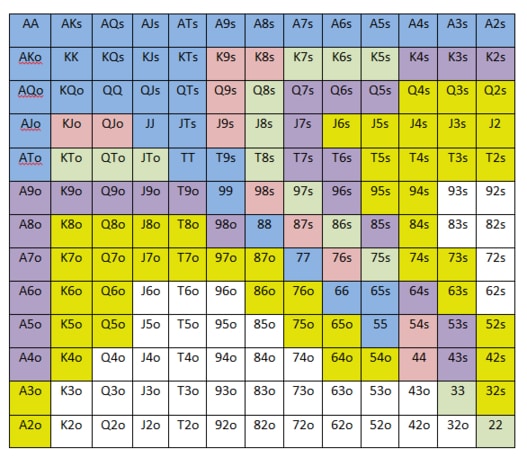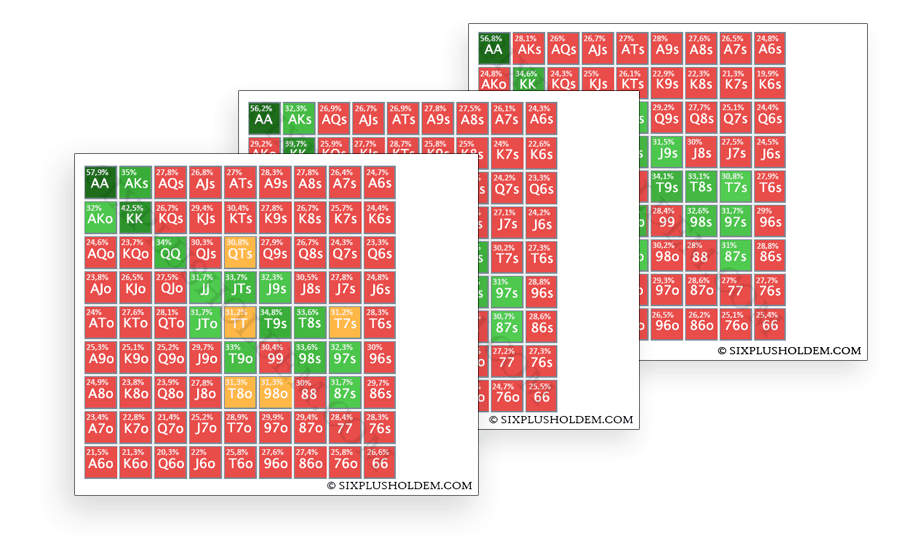Starting Hand Chart Texas Holdem
- Holdem Poker Starting Hands Chart
- Starting Hand Chart Texas Holdem
- Starting Hand Guide Texas Holdem
- What Starting Hands To Play In Texas Holdem
- Internet Texas Holdem Starting Hand Chart
- Texas Holdem Hands To Play

The affiliate Texas Holdem Starting Hand Chart program of this gambling site is run by MegaPartners Affiliates, a program that has been running since a years. With this program, you will be able to claim commissions of up to 50%. The percentage you get from the affiliate Texas Holdem Starting Hand Chart. Playing Texas Holdem online might even be the easiest way to get comfortable with the rules of Texas Hold’em as you can play hands at a much faster pace. You can choose to play for real money, of course, or you can start playing the free Texas Holdem games offered at every site. Official Poker Hand Rankings Know your poker hand order. A poker hand consists of five cards, which fall into several categories. Below is the complete list of poker hands, from highest to lowest. Please note that hand rankings for Short Deck are slightly different. Find out more about the short deck poker hand rankings on the dedicated page. The PokerStrategy.com Starting Hands Chart for No Limit Texas Hold'em shows you which hands you should play and how you should play them. Simply print it out and you will always know what to do throughout the entire game. Free poker money tip: Before you start playing with your free poker money, click here to download the chart!
NL Hold’em Starting Hand Charts
Holdem Poker Starting Hands Chart
One aspect of the game of No-Limit Hold’em that causes beginning players much grief is deciding which hands to play and which hands to dump. NL Hold’em is much more difficult than Limit Hold’em because the value of a hand depends on so many factors other than just the cards in your hand. Despite this difficulty, our coaches believe that following some general guidelines and adjusting from these is a better solution than having no guidelines at all. Given that well over half of your profitability in NL Hold’em is based on hand selection alone, we have developed these charts to help you better determine whether to play or fold.
There are no perfect No-Limit starting hand charts. That is because there are many factors that affect your decision, and charts cannot account for all of them. Some of these include:
- The size of your opponent's stacks.
- How loose or tight, passive or aggressive, your opponents are.
- Where these opponents are located at the table – for example, does an aggressive player still have to act after you?
- Your image at the table – for example, how tight or tricky you are perceived.
That being said, these charts will serve you well in most typical low-stakes No-Limit cash games, such as games with blinds of $1/$2, and home games. These games typically have several loose players at the table, and good opportunities for winning big pots with suited connectors and pocket pairs. With practice, you will be able to be a consistently winning player with these charts as a starting point. As you improve, you'll find yourself making adjustments to these charts based on the factors listed above, and more.
AGAIN: These charts are a good starting point for beginners. Specifically, Chart #1 recommends a significant amount of limping. This is great in loose, passive games but less often seen in tougher games. You’ll find other training material on Advanced Poker Training that may recommend a more aggressive approach for more experienced players.
Note: It would be a serious mistake to apply these hand charts before reading the Frequent Asked Questions first.
CHART #1 ‐ LOOSE, PASSIVE GAME (OFTEN 4-5 LIMPERS PER HAND)
NO ONE HAS RAISED YET
- Raise Always
- Call from Early Position, otherwise raise
- Call always
- Call from Middle or Late Position if the conditions are right (see Frequently Asked Questions)
CHART #2 ‐ TIGHTER GAME (FEWER LIMPERS) OR MORE AGGRESSIVE GAME
NO ONE HAS RAISED YET
- Raise Always
- Call from Early Position, otherwise raise
- Call (or Raise) from Middle or Late Position if the conditions are right (see Frequently Asked Questions)
CHART #3 ‐ THERE HAS BEEN A SINGLE RAISE
(3‐5 TIMES THE BIG BLIND) BEFORE YOU
- Re‐Raise Always
- Call from Early Position, otherwise re‐raise
- Call always
- Call from Middle or Late Position if the conditions are right (see Frequently Asked Questions)
FREQUENTLY ASKED QUESTIONS
For the hands in yellow, what do you mean when you say to play these hands if the conditions are right? The hands in yellow are speculative hands. They should always be folded from Early Position. From other positions, they can be profitable given the right conditions. Some of the questions to ask yourself:
- Are there other players who have called so far (the more, the better)?
- Are the players who have called playing poorly after the flop? Will they pay me off if I hit something?
- Is there an aggressive player still to act behind me (you might get raised and have to fold)?
- If there has been a raise and no other callers, what chance do I have of using my position after the flop to win the hand even if I don't improve (Chart #3 only)?
Why does Chart #2 say to sometimes raise with the hands in yellow, but Chart #1 does not? We have different goals in mind. Using Chart #1, we want to call to encourage additional players to enter the pot. These hands will be immensely profitable when our loose, passive opponents enter the hand, and get trapped when we flop a set, or make a well-disguised straight. When using Chart #2, however, we want to size up the opponents still to act. If they are tight, we can raise. Sometimes, we'll pick up the blinds. Other times, our pre-flop aggression will allow us to take down the pot on the flop.
What's the difference between AKs and AKo? AKs means an Ace and King of the same suit. AKo means an Ace and King of different suits.
What are early, middle, and late position? Early Position is generally the first 2 (in a nine player game) or 3 (in a ten player game) positions after the blinds. Late Position is the “cutoff” position (to the right of the dealer), and dealer button positions. Middle Position is everything in between.
How much should I raise? As a general rule, raise 3 to 4 times the big blind, plus 1 extra big blind for every player who has called before you. So if there are 2 callers already, raise between 5 and 6 times the big blind.
What if someone raises after I call? Whether you call the raise depends on how much money the raiser has for you to win, how many other players are involved, and what type of hand you have. As a general rule, if you have a pocket pair, lean towards calling. If there are a lot of other players (and therefore a big pot), lean towards calling. In general, fold suited connectors from early position. Fold hands like KQ that don't play well against a raiser.
How do I play from the blinds? From the small blind, play the same hands you would play from late position, plus a few more. But don't call with junk hands like T5o, just because it is “cheap”. From the big blind, if there is a raise to you, play like you would if you had already called from early position.
The chart says to fold KQo to a raise. Really? Yes, this hand performs very poorly against typical raising hands. Against AK, AQ, AA, KK, QQ, you are a big underdog. Other typical raising hands like JJ, TT, 99, AJs, are slightly ahead of you as well. The only time you might call or re-raise is from late position, if the opener was in middle or late position, indicating they might have a wider range of hands.
I was told to fold AJo from Early Position, why do you say to call with it? Folding AJo is not a bad idea in many games. We included it because, at low stakes tables (even tight or aggressive ones), the players are often playing badly enough after the flop that it can be profitable. We used data from millions of hands of low-limit poker to analyze this. The same could be said for KQo, ATs, and KJs – you can make a small profit in the long run at most low-stakes games, but folding would be perfectly acceptable from early position.
Can I use these charts in a NL Hold'em tournament? The charts would be best applicable to the early stages of a NL tournament, when everyone has a deep stack. In the middle and later stages, they should not be used.

Read all our instructional articles
Poker odds charts come in useful when you want to quickly work out the odds of winning a hand in Texas Hold'em. The most commonly used odds charts are the 'standard poker odds charts' below, which give both the percentage and ratio odds of completing your draw depending on the number of outs you have (see pot odds and drawing hands for more information).
The second set of odds charts highlight interesting odds for different situations in Texas Hold'em. These will help you get to grips with the different likelihood's and chances within the game of poker.
Standard poker odds charts.
Other poker odds charts.
Why use these odds charts?
There are currently many odds charts on the Internet at numerous poker websites. However many of these can be tricky to use. ThePokerBank provides easy to use charts highlighting the key draws on each, which makes them simple and effective to use during play.

I am confident that these odds charts are the easiest charts that you will ever use.
How to use poker odds charts.
Poker odds charts help you to determine how much you can call when trying to complete a drawing hand, such as a flush or a straight draw. By comparing your pot odds with the odds of completing your draw, you can work out whether or not it will be profitable to call certain sized bets from your opponents.
Poker odds charts are most commonly used when working out pot odds.
It is perfectly possible to work out the odds of completing a draw in your head, but these odds charts make things much easier if you are looking for a quick reference or if you're just starting out. However, over time it is a good idea to learn the most common odds so that you no longer have to refer to any charts whilst you play.
Starting Hand Chart Texas Holdem

Starting Hand Guide Texas Holdem

What Starting Hands To Play In Texas Holdem
Work out probabilities for yourself.
Don't just take my word for it or settle for the probabilities I've listed on the site, try working out probabilities for yourself. It's not as tricky or mathsy as you might think.
Internet Texas Holdem Starting Hand Chart
My guide on how to work out preflop hand probabilities gives a nice overview on basic starting hand probabilities. For flop probabilities and the likelihood of different combinations of cards on the flop, try the article on working out flop probabilities.
Texas Holdem Hands To Play
Go back to the handy Texas Hold'em tools.